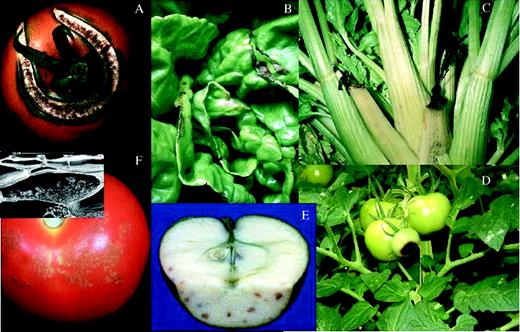Understanding Calcium deficiency issues in plants
Calcium is one of the most difficult elements to properly supply to plants as its absorption is tightly linked to both chemical and environmental factors. It is very easy for growers to suffer from calcium-related problems, especially those who are growing under highly productive conditions. Issues such as bitter pit in apples, black heart in celery, blossom end rot in tomato, and inner leaf tip burn in lettuce, have all been associated with low levels of calcium in the affected tissues. In this post, we are going to discuss why this happens, how it is different for different plants, and which strategies we can use to fix the issue and get all the calcium needed into our plants’ tissue. Most of the information on this post is based on these two published reviews (1, 2, 3).
Problems with Ca absorption rarely happen because there is not enough Calcium available to a plant’s root system. In hydroponic crops, these issues happen when ample Ca is available to plant root systems and can present themselves even when apparently excess Ca is present in the nutrient solution. Concentrations of 120-200 ppm of Ca are typically found in hydroponic solutions and we can still see cases where nutrient Ca-related problems emerge. This is because issues with Ca are mostly linked to the transport of this element from roots to tissues, which is an issue that is rarely caused by the concentration of Ca available to the plants. Most commonly these problems are caused by a plant that is growing under conditions that are very favorable and Ca transport fails to keep up with other, more mobile elements. As the plant fails to get enough Ca to a specific growing point, that tissue will face a strong localized Ca deficiency and will die.

When looking into a Ca problem and how to fix it, we first need to understand which plant organ is lacking proper Calcium uptake. In tomato plants, for example, blossom end rot (BER) appears when Ca fails to reach a sink organ – the fruit – while in lettuce, inner tip burn develops because Ca is unable to reach a fast-growing yet photosynthetically active part of the plant. Since Calcium transport can be increased by increasing transpiration, we might think that decreasing the relative humidity (RH) might reduce BER but this in fact increases it, because transpiration increases faster in leaves, than it does in the fruit. In this case, solving the problem involves balancing Ca transport so that it reaches the fruit instead of the leaves. Pruning of excessive leaf tissue, lowering N to reduce vegetative growth, and increasing RH – especially at night – can in fact help under these circumstances, where Ca deficiency develops in sink organs. Reducing ammonium as much as possible can also help, as ammonium can also antagonize calcium absorption due to its cationic nature.
In plants like cabbages and lettuce, a different picture emerges. In this case, increasing the RH leads to worse tip burn symptoms, and decreasing it significantly reduces tip burn, as Ca transport is increased by the increased leaf transpiration. This can be a viable strategy if the temperature is not too high. Under high temperatures, reducing RH leads to too much water stress, which causes other problems for the plants. In these cases, a preferred technique to reduce tip burn is to increase air circulation, which decreases both the RH around leaf tissue and the temperature of the plant due to the wind-chilling effect, this can increase transpiration rates without overly stressing plants.

Since in most cases these Ca issues are associated with fast growth, most measures that reduce growth will tend to reduce the severity of the Ca symptoms. Reducing the EC of solutions, reducing temperatures, and decreasing light intensity are some of the most popular mechanisms to reduce Ca problems by reducing plant productivity. These might be the most economical solutions – for example, if artificial lights are used – but it might not be favored by many growers due to the fact that it requires a sacrifice in potential yields. A potential way to attack Ca issues through growth control without reducing yields is to use growth regulators in order to suppress vegetative growth. Synthetic and natural gibberellin inhibitors are both effective at this task.
A common strategy to tackle these Ca issues is to perform foliar sprays to correct the deficiency. Weekly, calcium nitrate or calcium chloride foliar sprays can help alleviate symptoms of tip burn and black heart. Spraying plants from a young age, to ensure they always have Ca in their growing tips, is key. When performing these sprays, primordially make sure all growing tips are fully covered, as Ca sprayed on old tissue won’t really help the plant, as Ca cannot be transported from old to young leaves.